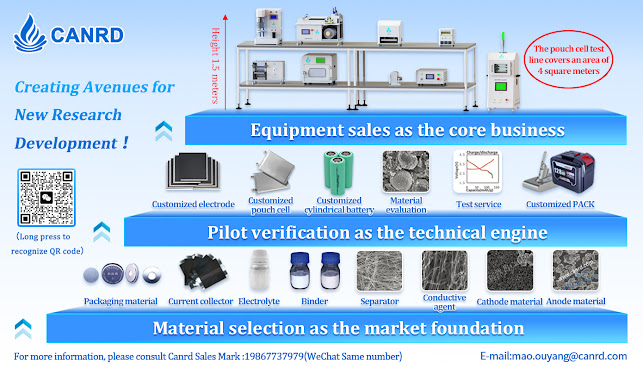Key auxiliary materials in lithium batteries - conductive agents
Conductive agent is an important auxiliary material for batteries, and conductive carbon black is the most widely used conductive agent. The main function of conductive agent is to improve the conductivity of batteries. Only a small amount of addition can greatly improve the performance of lithium batteries. Conductive agent products include conductive carbon black, carbon nanotubes, graphene, etc., which are important auxiliary materials for batteries.
The normal charging and discharging process of lithium batteries requires the participation of lithium ions and electrons. This requires that the electrodes of lithium-ion batteries must be mixed conductors of ions and electrons, and the electrode reaction can only occur at the junction of the electrolyte, conductive agent, and active material. The positive electrode active materials are mostly transition metal oxides or transition metal phosphates, which are semiconductors or insulators with poor conductivity, and conductive agents must be added to improve conductivity.
The conductivity of the negative electrode graphite material is slightly better, but during multiple charge and discharge cycles, the expansion and contraction of the graphite material reduces the contact between the graphite particles and increases the gaps between them, making them "dead" active materials that no longer participate in the electrode reaction. Therefore, a conductive agent needs to be added to maintain the stability of the conductivity of the negative electrode material during the cycle.
The core function of the conductive agent is to increase the conductive contact between active materials and improve electronic conductivity, that is, to collect microcurrents between active materials and between active materials and current collectors to reduce the contact resistance of the electrode and accelerate the movement speed of electrons.
Conductive agents enter lithium batteries during the preparation of the electrode slurry. The preparation of the electrode slurry is to mix the active material, conductive agent, and binder in a certain proportion, and then use a mixer to highly disperse the slurry to form a uniform slurry for the next step of foil coating.
The commonly used conductive agents for lithium batteries currently include carbon black, conductive graphite, VGCF (vapor-grown carbon fiber), carbon nanotubes and graphene, etc. Among them, carbon black, conductive graphite and VGCF are traditional conductive agents; carbon nanotubes and graphene are new conductive agent materials.
① Conductive graphite: Conductive graphite has good conductivity. The particles are in point contact with each other, which can form a conductive network structure of a certain scale . It can increase the conductivity rate and increase the negative electrode capacity when used in the negative electrode.
② Conductive carbon black: Conductive carbon black is a general term for molten polymers formed by the thermal decomposition of small carbon particles and hydrocarbons in the gas phase. It is a kind of agglomerate structure composed of spherical nano-scale particles agglomerated into multiple clusters and fibers. The particle size is almost one tenth of the particle size of conductive graphite. It is characterized by small particle size, large specific surface area, high structure, clean surface (few compounds), etc.
③ Carbon fiber: Conductive carbon fiber has a linear structure and is easy to form a good conductive network in the electrode, showing good conductivity, thereby reducing electrode polarization, reducing battery internal resistance and improving battery performance. In the battery with carbon fiber as a conductive agent, the contact between the active material and the conductive agent is point-line contact, which is not only conducive to improving electrode conductivity, but also can reduce the amount of conductive agent and increase battery capacity compared to the point-point contact between conductive carbon black and conductive graphite.
④ Carbon nanotubes: As an emerging conductive agent, carbon nanotubes can not only act as "wires", but also have a double-layer effect, giving full play to the high-rate characteristics of supercapacitors. Their good thermal conductivity is also beneficial to the heat dissipation during battery charging and discharging, improving the high and low temperature performance of the battery and extending the battery life.
⑤ Graphene: As a new type of conductive agent, graphene has a unique sheet structure (two-dimensional structure) and its contact with the active material is point-to-surface contact rather than the conventional point-to-point contact form. This can maximize the role of the conductive agent and reduce the amount of conductive agent, so that more active materials can be used to increase the capacity of lithium batteries. However, due to its high cost, difficulty in dispersion, and the disadvantages of hindering lithium ion transmission, it has not yet been fully applied in industry.
China maintains a world-leading position in carbon nanotube research and has taken the lead in achieving industrialization. Since 2001, domestic companies have successively invested in research and development in this field, gradually solving industrialization problems such as continuous preparation of carbon nanotubes, catalysts, and purification. With the rapid growth of the domestic new energy market, the demand for power batteries has risen sharply. The performance advantages of carbon nanotubes over carbon black and the realization of localization have made the conductive agent industry present a trend of replacing traditional carbon black with new products.
In the future, the development of the conductive agent industry will pay more attention to technological innovation and performance improvement. By optimizing the formula and production process of the conductive agent, its conductive performance and stability can be further improved, thereby meeting the market demand for high-performance conductive agents.
Canrd Brief Introduce
Canrd use high battery R&D technology(core members are from CATL) and strong Chinese supply chain to help many foreign companies with fast R&D. We provide lab materials,electrodes, custom dry cells, material evaluation, perfomance and test, coin/pouch/cylindrical cell equipment line, and other R&D services.
Email:janice@canrd.com
Phone/Wechat/WhatsApp/Skype:+86 18928276992
Website : www.canrud.com











No comments:
Post a Comment